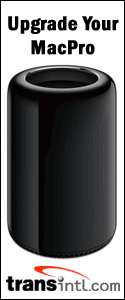
UNFINISHED BUSINESS: Originally posted June 15th, 2007 by rob-ART
morgan, mad scientist APERTURE TESTING PC GAMING vs Mac GAMING We are wondering if any of you are seeing the same disparity. CORE CLOCK and MEMORY CLOCK SPEEDS of 8600M vs X1600 WHEN DO I NEED MORE VRAM? It was suggested that we test the 3D games at "Ultra" Quality in Doom 3 and Quake 4 to see if that creates a bigger gap between the 128M and 256M models. We also plan to try enabling 4X FSAA to see what impact that has. COMING SOON RELATED ARTICLES See the 15" MacBook Pro (128M VRAM) vs 15" MacBook Pro (256M VRAM) "Santa Rosa" shootout. We included the 17" model, too. See our "CPU Crunching" article comparing the "Santa Rosa" MacBook Pro to other Apple laptops running Photoshop CS3, After Effects CS3, Compressor 3, and Motion 3. WHERE TO BUY YOUR MACBOOK PRO "Santa Rosa" or other Apple products You can also purchase Apple systems and accessories from Small Dog Electronics. You can custom order from them just like with the Apple Store. PRE-ORDER LEOPARD WHERE TO BUY MEMORY FOR MAC LAPTOPS TransIntl.com is selling kits to take your "Rosa" MacBook Pro to 4GB. They also have kits to take your 13" MacBook to 3GB. Other World Computing sells various kits for the MacBook and MacBook Pro. They have done extensive testing with the 13" MacBook to see what gain is made from matching pairs -- including dual 2GB modules. Has Bare Feats helped you? How about helping Bare Feats? © 1995 - 2007 Rob Art Morgan
MacBook Pro "Santa Rosa" Testing
-- You Can Help
Lots of requests for Aperture results on the MBP. I want to do meaningful Aperture tests but I want to be sure I'm testing functions that use the GPU, not just CPU.
I'm using Hardware Monitor to monitor various things including GPU usage %. When I do a lift and stamp, the CPUs on the MacBook Pro are cranking at 200%, but the GPU is only at 2%. The same is true for re-generating Previews.
Moving the Loupe around averages about 20%, but that's not quantifiable in terms of elapsed time.
Compare that to Motion 3 which uses up to 40% of the GPU while rendering a RAM preview of Mortise 2 NTSC or Quake 4 (and other 3D OpenGL games) that "peg" the GPU at 98%.
Here's what you can do to help. Please download a copy of Hardware Monitor. With the overview window open, scroll down to the bottom. The second to the last parameter is "Graphics Processor" and a percentage. Try doing some typical functions you do in Aperture and let me know which ones use at least 50% of the GPU.
iMAC C2D TESTING
Some of you asked us to add the iMac C2D numbers to the MacBook Pro "Santa Rosa" CPU Crunch page. However, we no longer have the iMac Core 2 Duo 2.33 in the lab. Nor do we have results in our database from software we are now using for CPU crunching (Compressor 3, After Effects CS3, Photoshop CS3, etc.)
The current top-of-the-line iMac uses the same processor and memory as the MacBook Pro Core 2 Duo (late 2006). The memory and frontside bus are also the same. So you can infer the iMac's performance from the MacBook Pro 2.33 results as far as pure CPU crunching. The iMac C2D only distinguishes itself when you run 3D games or Motion 3 -- and then only when you have the optional 7600 GT GPU.
Having said that, we still are attempting to get iMac C2D back in the lab or borrow time on one for follow-up testing. Also, if Apple announces a "Santa Rosa" iMac, we'll certainly purchase one of those for the lab -- especially if its bezel is in aluminum to match our other systems. ;-)
Meanwhile, if you have a 2.33GHz iMac C2D 20" or 24" and own copies of Photoshop CS3, After Effects CS3, Aperture, Motion 3, or Compressor 3, we'd love to hear from you and give you some tests to run for us.
MOTION 3 TESTING
Motion 3 is disappointing in one aspect. It only uses 100% CPU even on the 8-core.
It does use up to 40% of the GPU, though, when rendering RAM previews on certain projects (Fire-Mortise 2 NTSC).
We're surprised Apple software engineers didn't take full advantage of the multi-core systems when they wrote the code. Hopefully, they will remedy that in a future revision running under Leopard.
LEOPARD TESTING
Speaking of Leopard, we used our WWDC budget to buy a MacBook Pro "Santa Rosa" 17" so we won't be among those with an early beta copy of Leopard. We received a note from Apple that the beta copy will eventually be available for download by developers who did NOT attend WWDC. At that time we be testing to see what effect it has, if any, on the performance of existing pro apps.
BATTERY DRAIN by MacBook Pro HARD DRIVES
We came up with a test that should measure this. Since Hardware Monitor measures the "current capacity" of the battery, we should be able to measure the capacity loss after running DiskTester "bashing" over an hour. We'll post results real soon.
We installed a copy of Prey under both Mac OS X and Windows XP Pro. In our first test, we ran at 960x600 in windowed mode, max quality settings, 4X FSAA, 4X anisotropic filtering. Under Mac OS, the 17" MacBook Pro 2.4GHz scored 37fps. Under Windows XP Pro, it scored 73fps. Hmmm.
In case you weren't aware, the core and memory clock speeds of the MacBook Pro's GPU are variable, depending on what you are doing. Though there is currently no Mac OS X utility to measure this on the newest laptops, we were able to confirm the frequencies of the newest MacBook Pros using ATITool under Windows XP Pro:
Radeon X1600
GeForce 8600M
GeForce 8600M
Core Clock idle
Core Clock normal
Core Clock max
Memory Clock idle
Memory Clock normal
Memory Clock max
* Video memory is double data rate so you multiply the speed times 2. In the case of the 8600M GT in the 17" MacBook Pro, the top memory speed is 650 x 2 = 1300MHz
Is there any situation where you could put the 256MB of GDDR3 SDRAM to work? I suppose if you are running your MacBook Pro in dual display mode with an external 30" Cinema display, which assigns 128MB to each display, it could help. And if you are running a video memory hungry pro application like Motion 3, it could help. We're still trying to find a way to quantify this.
We'll be posting a full report on the transfer rates and battery use rate of the optional Seagate 160GB 7200rpm Momentus 7200.2 notebook drive for the MacBook Pro "Santa Rosa." We'll compare it to the 5400rpm standard drive as well as the newest high-end notebook drive, the Hitachi 200GB 7200rpm Travelstar 7K200 -- which is giving us 71MB/s READS and 68MB/s WRITES. Eeeeha!
See the 3D Gaming Shootout we posted recently comparing the newest MacBook Pro "Santa Rosa" to other Macs. (We added the 17" results to this, too.)
If you live in the USA and plan to purchase an APPLE product, please CLICK THIS LINK or any APPLE DISPLAY AD to help us earn our affiliate commission. It's a great way to help support Bare Feats.
Amazon is offering the opportunity to pre-order Apple Mac OS X Version 10.5 Leopard
We have tested the memory from the following third party companies in our MacBook Pro "Rosa" and MacBook. We can recommend them wholeheartedly:
"BARE facts on Macintosh speed FEATS"
Email
, the webmaster and mad scientist






